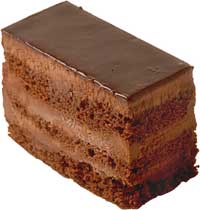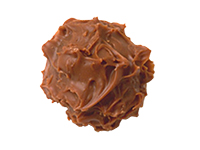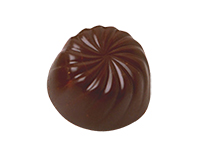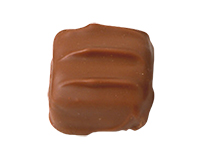The chocolate challenge Teach article
John Schollar from the National Centre for Biotechnology Education at the University of Reading, UK, finds an excuse for eating one of his favourite foods - chocolate.

Every country in Europe seems to have its own favourite chocolate, and the characteristics of the best-selling brands vary greatly. Thus, milk chocolate with a caramel note dominates the English market while the French prefer darker chocolate with a greater content of cocoa solids. How can different brands of chocolate be objectively compared, and how can quantitative data be obtained from such comparisons? Here are some simple yet effective comparative procedures that are widely used in the food industry. Typically, they are used for quality control, to assess changes in the product (for example, as a result of changes in raw materials or production methods), to monitor shelf life and to assist in the development of new products. The methods yield data suitable for statistical analysis and can be used for chocolate or for other food products such as fruit juice or biscuits.
Preparing the chocolate
For this exercise, you will need a minimum of three different products. The maximum number of brands you can compare will be determined largely by the time you have available, but in practice it is difficult to compare more than six products. We usually find that four different types of chocolate, carefully selected to give a range of characteristics, are ideal for a classroom activity.

To avoid bias, the chocolate should be presented to the students without identifying the brand. Identify each of the products with a three-digit code picked at random so that there is no number bias.
Manufacturers’ names are often moulded into chocolate bars, so you may wish to remove the name to preserve the anonymity of each type of chocolate. This can be done in two ways. We have a laboratory heating block set to 40 °C, which we cover with a clean sheet of aluminium foil. We place the each chocolate bar face down on the foil for a few seconds until the manufacturer’s name has been melted away. If you do not have a heating block, remove the name with a spoon or knife that has been warmed in boiling water; this takes a little time, but it is effective as most chocolate melts at about 37 °C. Unfortunately the shapes of chocolate bars often provide a clue about the identity of the brand, so removing the name may not be a fool-proof means of ensuring that the tasters are not biased.
Once the names have been removed, cut chocolate into pieces that are suitable for tasting – we usually provide students with pieces about 10 mm square.
For each working group, put samples of each type of chocolate into separate clean plastic bags, labelled with the appropriate identification code. Provide one sample for each student (we usually ask students to work in groups of four).

Materials and equipment needed by each person
- Three or four different brands of chocolate, cut into small squares about 10 mm x 10 mm (one sample of each type)
- A clean paper plate on which to place the chocolate samples
- A glass of water for cleaning the palate after tasting each sample
- Photocopied sheets (here) on which to record the results
- A ruler marked in millimetres
- Coloured pencils (a different colour for each type of chocolate)
Procedure
- Taste each chocolate sample in turn, and as you do so, use the sensory testing chart to record the characteristics of each brand of chocolate. Use a different coloured pencil for each chocolate sample. Take a sip of water after tasting each sample to refresh your palate.
- Measure the distances between the beginning of each line and the coloured marks you have made on the lines. Convert the positions marked for each characteristic for each chocolate sample into percentage values, and record these values in the personal summary table. Note that each line on the first chart is 100 mm long, so that the positions marked on the line are easily converted into percentages.

- Collate the results for your group in the group summary table. Note that it may be easier if you divide the work and one person collects all the data for one chocolate type.
- Calculate the group mean for each characteristic. If desired, you may also collect the data for the entire class.
- In the chart below, plot a sensory profile (zero at the centre, 100% at the extremity) for each chocolate brand. Each brand of chocolate will have a sensory profile represented by a different shape. If you use coloured pencils for this, all the data can be shown on one chart.
- If time allows, the data for the entire class can be collated and compared. Your personal perception of each chocolate’s characteristics can be compared with group or class results.
- Finally, discover the identity of each of the different brands of chocolate you have tasted. Look at the ingredients such as milk and cocoa solids listed on the wrappers for each of the chocolate samples. Try to relate the results you have obtained to information on chocolate wrapper and any advertising claims made for each brand.
Safety
For reasons of hygiene, wear disposable plastic gloves while you are preparing the chocolate. The samples must be prepared in a kitchen or room suitable for food preparation, not a laboratory. The chocolate should not be tasted in a laboratory.
IMPORTANT! Teachers should be aware that some students may have food allergies (e.g., to nuts) and will therefore be unable to carry out this work.
Preparation and timing
The activity takes about 60 minutes. The chocolate samples should be prepared in advance.
Resources
- Further information about chocolate manufacture, including practical investigations suitable for the school laboratory are given in:
- Beckett ST (2004) The Science of Chocolate. London, UK: Royal Society of Chemistry
- Additional information is provided in Chapter 12 of:
- McGee H (2004) McGee on Food and Cooking: an Encyclopedia of Kitchen Science, History and Culture. London, UK: Hodder and Stoughton Ltd
- A useful compendium of chocolate facts and figures is provided in:
- Ayral D (2001) A Passion for Chocolate. London, UK: Cassell & Co





